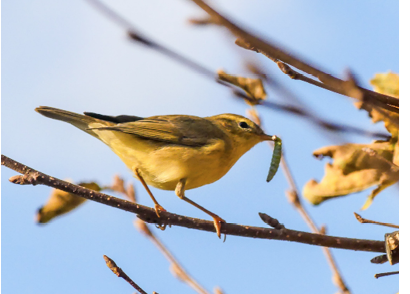David M. Larson

Willow Warbler. Photograph by Mike Prince (CC BY 2.0).
In the bird world, it takes at least two to tango. Ratios of males to females in breeding populations may vary for a variety of reasons, even if there is equal probability of hatching in male and female. Often sex ratios are male-biased, especially in declining or small populations. There have been relatively few studies of the causes and consequences of male-biased breeding populations in bird species.
Morrison, et al. (2016), addressed these issues by studying country-wide population data from banding stations in the United Kingdom, concentrating on Willow Warblers, Phylloscopus trochilus, migratory passerines which vary widely in abundance in the United Kingdom. Willow Warblers are more common in the north and west, and less common in the south and east. These banding stations all use the British Trust for Ornithology Constant Effort Sites protocol with mist nets in the same locations and same amounts of time during a set number of morning or evening sessions between May and August. Data from capture-recapture were used to estimate annual survival of adult birds for 34 stations. In addition, birds were sexed in the hand by banding station personnel. In this study, over 80% of adults were sexed on at least one capture. The other main data set used came from the national Breeding Bird Survey (BBS) data. Between 1994 and 2010, BBS surveyors recorded bird abundance along two parallel 1 km transects in 1 km2 survey blocks, twice per breeding season. Maximum counts of adult birds during the breeding season were fit to mathematical models as a function of latitude and longitude.
Use of these data sets yielded estimates for survival rates for adult birds and differential survival rates by gender. The authors found that estimated adult sex ratios, expressed as proportion of males, varied considerably among the Constant Effort Sites, with male-biased sites more common in the southeast. Throughout Britain, sex ratios have become more male-biased over time, from 50% males in 1994 to 60% in 2012. Including the abundance of Willow Warblers into the analyses, the banding sites with the highest density of Willow Warbler abundance had sex ratios close to equal, while those sites with lower predicted abundance had more male-biased populations. Annual survival of females was slightly less than males. The production of juveniles, as a measure of local productivity, was highest at equal sex ratios and declined as sex ratios skewed. Significantly fewer juveniles per adult were produced at male-biased sites with low Willow Warbler abundance.
Male-biased sex ratios are a hallmark of small and declining populations, especially in endangered species. In Morrison, et al. (2016), the authors found male biases in areas with small Willow Warbler populations, and this phenomenon is increasing, possibly due to habitat fragmentation, especially in the southeast. So, what causes male-biased sex ratios? The drivers could include higher mortality in females, although the measured differences seem unlikely to be sufficient to drive this phenomenon. In marginal breeding habitat, higher female predation or loss due to breeding stress could be factors. However, the reasons could be behavioral. Higher rates of female natal dispersion, compared to males, could lead to females preferentially recruiting into breeding grounds with high abundance or higher quality habitat. In this study, higher dispersion of females could contribute to the described male bias and lower apparent female survival in lower quality breeding habitats.
When adults are unable to successfully breed in areas of skewed sex ratios, fewer young will be produced, which can exacerbate the problem. So, for conservation practices for declining species, it may make more sense to concentrate on higher quality habitats with robust populations rather than expend energy and funds to try to bolster sagging populations.
This paper uncovers an additional caveat for researchers who rely on bird song, typically more common in males, for estimates of breeding population. Males who have not found a mate will often continue to sing vigorously, advertising for nonexistent females, while successful males may tone it down. Hence using song as an easy proxy for estimating population may mask underlying problems, such as skewed sex ratios or female mortality, if much of that song is coming from the lovelorn nonbreeders. Similar effects could be manifest on our side of the Atlantic. Certainly, there is no dearth of declining species in North America. In Britain, the combination of widespread banding stations following a set Constant Effort Sites protocol and a rigorous Breeding Bird Survey protocol make asking these questions easier.
Reference
- Morrison, C.A., R. A. Robinson, J.A. Clark, and J.A. Gill. 2016. Causes and consequences of spatial variation in sex ratios in a declining bird species. Journal of Animal Ecology 85: 1298-1306.
David M. Larson, PhD, is the Science and Education Coordinator at Mass Audubon's Joppa Flats Education Center in Newburyport, the Director of Mass Audubon's Birder's Certificate Program and the Certificate Program in Bird Ecology (a course for naturalist guides in Belize), a domestic and international tour leader, President of the Nuttall Ornithological Club, and a member of the editorial staff of Bird Observer.